Whether a rookie driver or an experienced one, you must know “how to tell if the power steering pump is bad or rack and pinion.” A power steering pump helps in the smooth functioning of the steering wheel. You get to experience effortless drive.
However, there are always chances of the power steering pump or rack and pinion having mechanical issues or complete failure. But do not worry. It is easy to get hold of the symptoms.
You will witness several signs like a tight steering wheel, grinding noise, & more. If not fixed soon, a poor steering mechanism can be life-threatening to the riders.
Thus, today we bring you this article covering the basics of a power steering pump, various warning signs indicating its failure or malfunction, and easy diagnosis & fix. So, let us get started and make you more familiar with your ride.
What Is Power Steering?
Power steering is an automotive system that uses engine power or a distinct motor to reduce the efforts required to turn the front wheels. This feature helps you steer your car & makes it simple to maneuver it, especially at slow speeds.
Types Of Power Steering
There are three types of power steering you can find in modern-day vehicles. All three types deliver the same function but use different methods to get the results.
- Hydraulic
- Electric
- Hybrid electro-hydraulic
You will find a few differences between them. But still, each one ensures you require less force to turn your car steering. The hydraulic power steering system is the most prominent of the three.
Hydraulic Power Steering
It is the oldest and one of the most prevailing power steering types. The system comprises a hydraulic pump assembly allowing power steering fluid to exert force on your vehicle’s steering assembly and turn the tires.
Suggestion: What Happens When Timing Belt Breaks While Driving?
In this system, the pump is belt-driven and gets energy from the engine’s rotation to do its work. The only shortcoming is that the pump runs continuously, even when you do not need power steering assistance.
Power Steering Pump
A power steering pump is a hydraulic system that provides pressure to the rack and gives dependable steering power with the help of drive belts.
The power Steering Pump is one of the most critical components of the power steering system. It is located within the steering system next to the steering gear & provides hydraulic power for the power steering system.
The power steering pump pressurizes the hydraulic fluid that assists in the turning of the steering wheel. The amount of pressure depends on the engine speed at that particular time.
The faster the engine moves, the more fluid the power steering pump releases. Lastly, a pressure relief valve lets the excess fluid return to the pump.
Importance Of Power Steering Pump
Before we deduce how to tell if the power steering pump is bad, it is better to learn about such a crucial part in detail. A steering pump is an integral part of your car’s steering system. With its malfunction, driving in a car can be dangerous.
Thus, knowing why such a small part plays such a significant role in your vehicle’s functioning is crucial. The steering pump draws hydraulic fluids from the return line with its vanes, which spin fast enough to pull out the liquid.
Related Post: Consider These Subaru Forester’s Engine Problems Before Buying
The pump then pushes the fluid into the pressure tube, creating hydraulic pressure to help the steering gear turn the wheels effortlessly. Apart from this, a power steering pump is crucial for a few other reasons:
- It assists in the safe & precise steering of your car
- It eliminates the need for extreme effort to steer the automobile
- The steering pump even absorbs some of the road shocks giving a smooth & comfortable ride
Top 7 Symptoms Of A Bad Power Steering Pump:
A power steering pump is responsible for giving you a more comfortable, accessible, and safe driving experience. It is a crucial part of your machine and thus requires immense care. If you do not follow proper maintenance procedures, your car steering system can fail quickly.
The worst thing about your power steering getting out is that severe damage can lead to replacement, which is a costly event. But you can avoid it all if you learn to notice the different signs of the power steering pump going out.
Only by keeping a check on the symptoms will you know if the power steering pump is substandard or not, and you can work on handling it immediately.
1. Slow Steering Wheel Response

The instant response of the car’s wheels to the steering wheel’s movement is a sign of a healthy steering system. If your steering wheel takes longer than usual to respond to your movement, it is in bad shape.
A slow-responding steering wheel is dangerous and can cause an accident in a situation where you need an immediate response.
2. Steering Fluid Leak
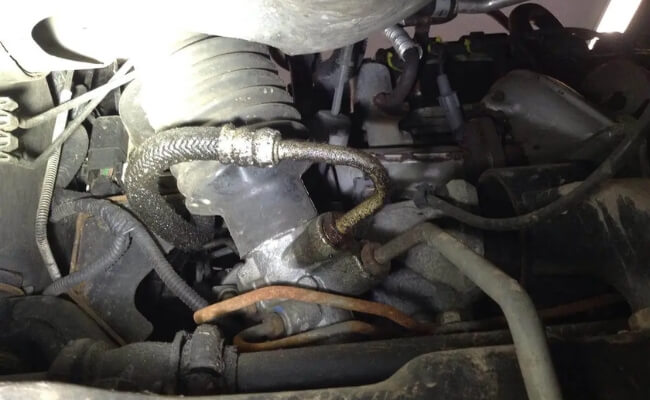
The leakage of steering fluid is only exclusive to hydraulic power steering. If you find an oil stain in your parked stop, it can be any of your automotive fluids.
And to ensure whether it is your steering fluid or not, you need your vehicle inspected. If the leak is the steering fluid, the steering racks are in poor condition.
3. Whining Noise When You Turn The Wheel
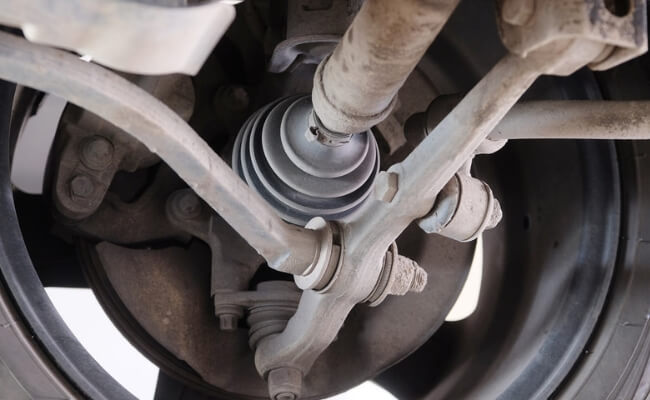
If you hear a whining noise when turning the wheel, it indicates that your power steering is going out. It mainly occurs due to either low power steering fluid or a leak.
Either way, it is a symptom that every car owner wants to avoid. To minimize the probability of this symptom, you should check the steering fluid level and refill as required. However, if your steering fluid level is okay, you need immediate professional assistance.
Also Check:
4. Stiff Steering Wheel

When the power steering pump is failing, it gets hard to steer. So, when such a situation arises, you should stop blaming it on your steering.
Instead, you need to take your ride to an auto repair shop & have the pump fixed or replaced, depending on the situation.
5. Squealing Noise Every Time You Turn The Key In The Ignition
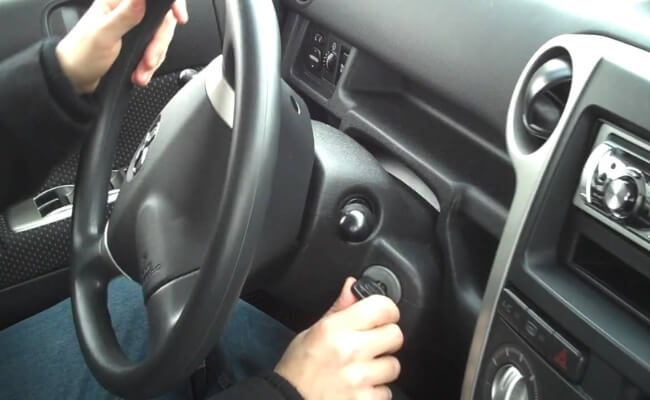
If every time you turn your key in the ignition and you hear a squealing sound, it is your ride indicating something is wrong with your steering pump.
You can also hear squealing noise while making turns. And in both scenarios, having your vehicle inspected is the right thing to do.
6. Groaning Noises
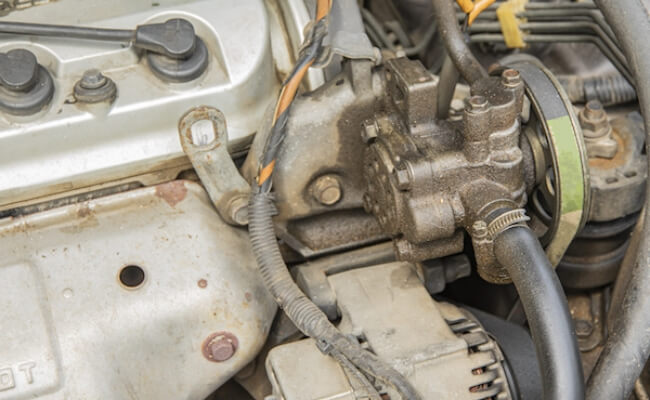
Your car making loud & distracting groaning noises is not ideal for you and the other drivers around you on the road.
Also Check:
These sounds can occur either due to a bad steering pump or anything wrong with some other parts. To know for sure, have your ride inspected by a professional.
7. Shaking Steering Wheel

The steering wheel of your ride is a rigid part. However, if you find it shaking often while driving, it is a sign of the power steering pump, rack, and pinion failing.
6 Crucial Components Of A Power Steering System
You can never have a smooth & effortless movement of your wheels until your power steering system has exemplary operating. A power steering system is not a single entity. It is a cluster of components that work collectively to serve you the best.
A steering system can not work if all of its components are not operating correctly. Thus, you need to learn about various elements of your power steering system.
Here we have explained all the essential elements that you should ensure are in their best condition to get the best driving experience.
1) Power Steering Pump
The most critical part of a vehicle’s steering system is the pump. It is driven by the engine’s serpentine belt, making it build up pressure in the control valve. The pump delivers the fluid to the rack and piston parts only under high pressure.
2) Rack & Piston
With every turn of your steering wheel, the pressurized fluid from the pump moves a toothed gear that helps in spinning the wheels. Both rack & piston are the toothed gears that decrypted the steering wheel movements into the wheel’s actions on the road.
Whenever you steer the wheel, the pinion turns against the rack, pushing it in the intended direction. Thus, redirecting your wheels effortlessly.
3) Steering Coupler
A steering coupler is a joint between the steering column and the input shaft. It helps in the alignment of both parts while allowing the steering wheel to spin without affecting the steering column.
4) Steering Yoke Assembly
The steering yoke or damper is a thick rubber between the steering column and rack & pinion input shaft. It ensures you get a smooth driving experience by absorbing road shocks and vibrations. It also prevents the shocks from getting to the driver through the steering wheel.
5) Hoses
A power steering system comprises two main hoses, one for each high & low side. The hoses can be built of high-heat rubber or stainless steel and attached to the rack & pinion assembly using copper or brass fittings.
Popular Post: Car Alarm Going Off Randomly? – Learn Why And How To Fix It!
The hoses on the high side carry high-pressure fluid to the rack, while the ones on the low side move the low-pressure fluid back to the pump.
6) Tie Rod Ends
The tie rod ends are placed at the ends of the steering rack. They deliver smooth rack motion transition into the movement of the front wheels.
The tie rods can move either diagonally or vertically. They can also have horizontal rotation and compensate for the bouncing effects on an uneven road.
What Is The Role Of Rack And Pinion In The Steering System?
Rack and pinion are among the most crucial components of the steering system, ensuring your vehicle is going in the right direction.
They use a gear set to convert the circular motion of the steering wheel into the linear motion required to turn the wheels. It also offers a gear reduction, so turning the wheels is effortless.
Both of these components are enclosed in a metal tube. The pinion gear is attached to the steering shaft and rack gear to the tie rods at both ends.
Suggestion: 6 Top Reasons For Car Losing Oil But No Leak Or Smoke: How To Fix It
Once the steering wheel comes into motion, the pinion gear works on translating the movement and also moves the rack to the left or right. Finally, the rack converts the pinion’s movement into linear motion, moving the wheels.
There are two critical functions of rack and pinion:
- Decreasing the effort required for the steering wheel to turn the wheels
- Translating the steering wheel’s circular motion into a linear one helps in the motion of the wheels
Top 5 Symptoms Of A Bad Steering Rack And Pinion
If your power steering system is going out, it does not necessarily indicate an issue with the steering pump. Sometimes the rack and pinion are to be blamed.
And you can differentiate which part is causing the problem by learning about the symptoms. Here we have listed five top symptoms that indicate whether your uneasiness to drive is related to rack & pinion or not.
1. Stiff Steering Wheel
If you feel your steering wheel is too tight or rigid to turn than usual, it is a sign of a poor steering rack. You can fix it immediately by adding more steering fluid or making some modest adjustments. However, for long-lasting results, you need to replace your steering rack.
2. Leaks
If there is a leaking steering fluid, it also indicates a faulty rack and pinion. You can locate a steering fluid by its red or pinkish color appearance.
3. Strong Burnt Odor
If you get a strong odor of burnt oil while you drive your car, it also indicates a busted rack and pinion. In such a scenario, you should stop & get out of your automobile immediately. Continuing to drive a car with this symptom can lead to fire explosion and fatal damage.
4. Dead Spot
If you can turn your steering wheel without feeling resistance, you have a dead zone. It means the rack is completely busted, and you need to replace it immediately.
5. Grinding Noise
Hearing grinding noises while driving is mainly if your ride is low on steering fluid. However, if that is not the case, it is a simple indication of a damaged rack and pinion.
Frequently Asked Questions ( FAQs )
What Happens When A Power Steering Pump Goes Bad?
When power steering goes inadequate, it becomes too hard to maneuver your steering wheel, or the wheel becomes free to move around.
In both scenarios, driving your car can be dangerous. Thus, you should get the issue fixed as soon as possible.
How To Diagnose A Bad Power Steering Pump?
Not every breakdown allows access to a professional at the doorstep. Also, not every issue in the steering pump, rack, and pinion requires an expert’s indulgence.
To ensure the level of severity & whether the issue is related to the steering system or not, you need to diagnose your ride.
- You can follow our steps below to get started.
- Start your engine and turn your wheel for movements
- Listen for whining or groaning noises
- Check if your steering has complete loss of power assist, less power support, or is completely stuck
If you find any of the mentioned signs, your steering needs to be replaced. And if not, there is some other issue with your ride. Thus, it will be wise to take it to an auto repair shop.
What Is A Power Steering Fluid?
A power steering fluid is a hydraulic fluid that helps transmit power in a power steering system.
It is a pressurized fluid that decreases the efforts required to turn the steering wheel. In addition, the fluid also ensures the power steering pump, valves, pistons, & hoses work as desired.
What Are The Different Types Of Power Steering Fluid?
There are three types of power steering fluid. But to know which one to use in your car, you need to refer to your owner’s manual.
- Automatic Transmission Fluid
Generally, this fluid is used for automatic transmissions. However, it can also be used in some power steering systems.
- Non-Synthetic Mineral Fluid
The vehicles or systems that accept the automatic transmission fluid can also run on mineral hydraulic fluids.
- Synthetic Fluid
A synthetic fluid is created in a lab and is used in most new vehicles. Generally, these kinds of fluids are engineered for specific steering systems or cars.
Is It Possible To Drive Without A Steering Pump?
YES. A steering pump is an accessory to your vehicle embedded in it to make your driving effortless.
If you do not have it in your ride, all that changes will be your force input to turn your vehicle.
Furthermore, most of the older cars did not have a pump.
How Long Does A Power Steering Pump Last?
There is no fixed expiration date on a steering pump. Its longevity depends on your driving habits and the quality of the product.
However, experts always suggest replacing your pump after about every 100,000 miles.
Can I Replace The Steering Pump Myself?
If you are a tech wizard and know how the mechanical system of a vehicle works, then sure.
However, it is always wise to have it replaced by a professional as the process can take hours and is complex.
Conclusion
A power steering system is a convenience added to a vehicle to let you have the best driving experience. And to enjoy it better you should make yourself familiar with it.
And we hope our detailed article answers your questions like how to tell if the power steering pump is bad or rack and pinion & more.















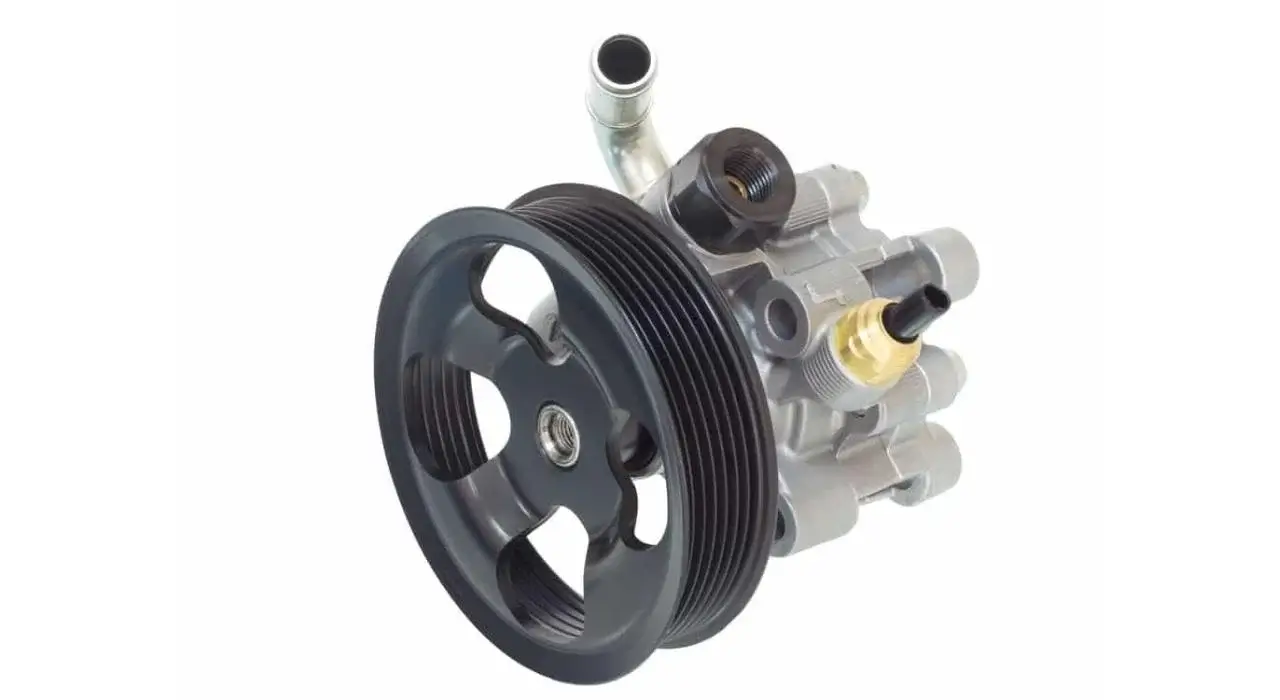

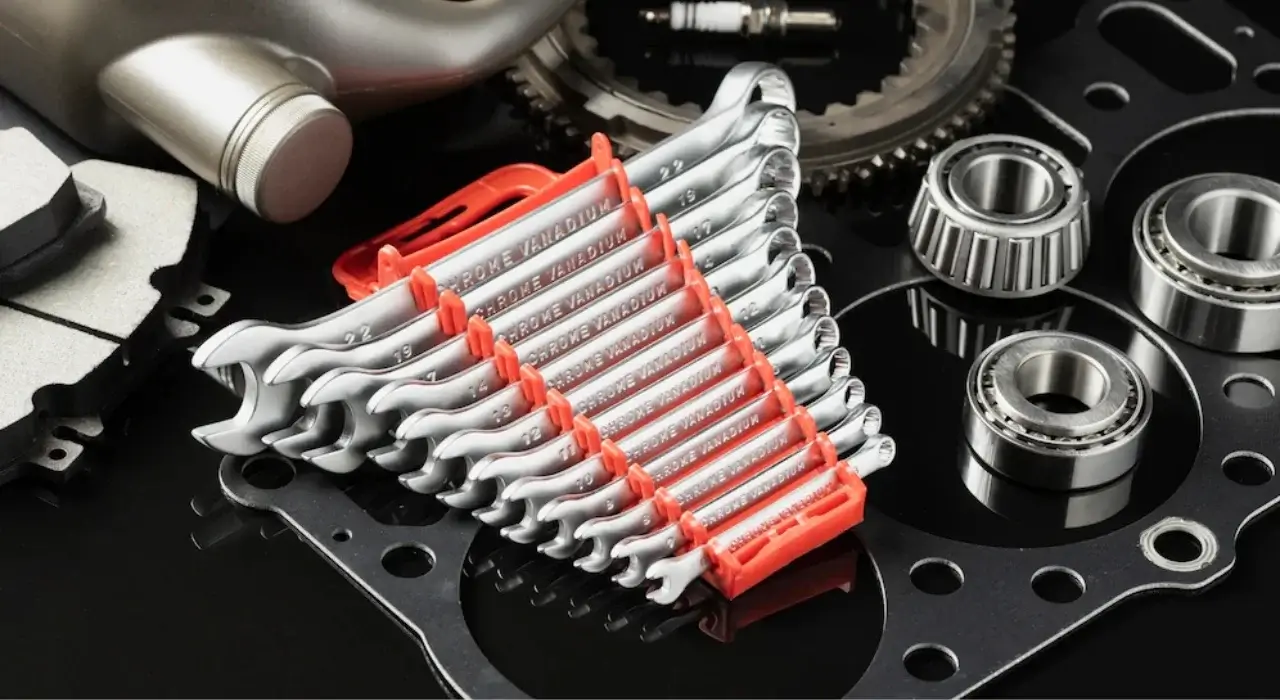


I have not changed the power steering fluid (10 years) . 1999 tacoma 4×4 I went to take my wife to the store during a freezing spell. I started the truck (ZERO POWER STEERING) I have flushed the fluid out ( I used a drill with a pump attachment. I turned the steering left,right, sucked the fluid out and repeated. I still have no power steering. What to fix first??????????????